AAC Implementation Framework: Step 4 – Try It!
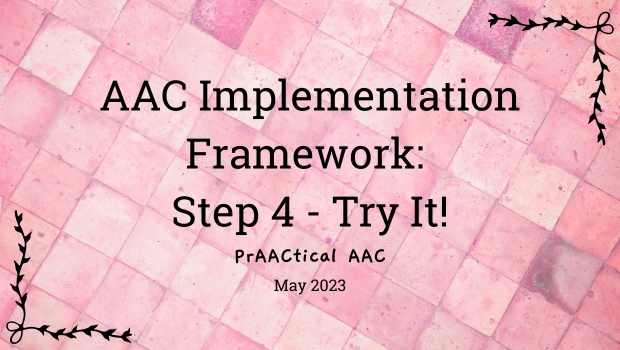
 We’re so pleased to welcome back PrAACtical AAC friend Vicki Clarke to these pages for another article in the AAC Implementation Framework series. Vicki heads up an AAC-focused private practice, Dynamic Therapy Associates, and is also the Director of DTA Schools. Today’s post includes ‘next step’ information to guide others in implementing AAC along with some helpful AAC posters for you to download, and a video with implementation tips.
We’re so pleased to welcome back PrAACtical AAC friend Vicki Clarke to these pages for another article in the AAC Implementation Framework series. Vicki heads up an AAC-focused private practice, Dynamic Therapy Associates, and is also the Director of DTA Schools. Today’s post includes ‘next step’ information to guide others in implementing AAC along with some helpful AAC posters for you to download, and a video with implementation tips.
If you are new to this series you can find the earlier posts through the links below.
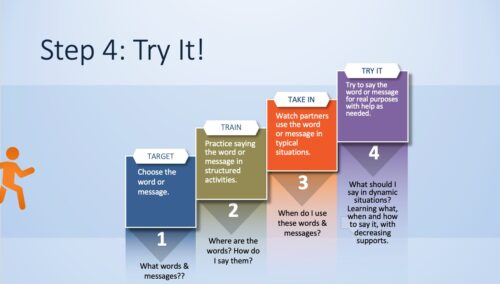 AAC 101: Steps To Learning
AAC 101: Steps To Learning
Step 4: Try It!
As we know, Augmentative and Alternative Communication (AAC) is an essential tool for individuals with speech and language disabilities to communicate effectively and engage in social interactions. Our 4th Step: Try It is about supporting our students as they take those first steps communicating with their AAC system during typical daily activities.
In this step, individuals with communication disabilities are given the assistance needed to use their AAC systems for communication purposes in their natural daily environments, with lots of support as they get started. The targets for communication, words and messages, will be the same ones that were initially chosen, taught, and modeled during Steps 1-3.
The previous step of modeling the words and phrases during typical activities makes this next move to communicating all day relatively easy for caregivers and teachers. They already know how to use the words and model them during these typical activities, and can begin to concentrate on providing the support that benefits the individual the most in becoming independent communicators.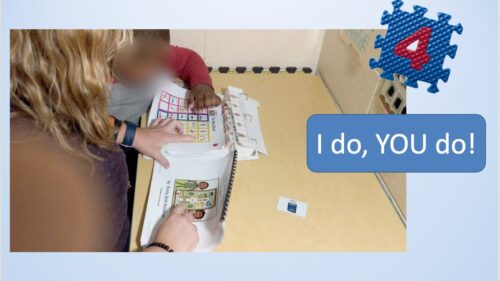
Caregivers and teachers will encourage and cue the individuals to say what THEY want to say, gradually reducing the amount of support provided until they become independent communicators. There are many resources here on PrAACtical AAC to help partners learn how to assist and encourage communication. At DTA, we teach our AAC partners using a set of Partner Strategy Kits, which include short video explanations and examples, guiding questions for teams to consider, and colorful 2-page posters to hang on the classroom walls with tips and reminders for the partners. Here’s a link to download a poster freebie for your classroom!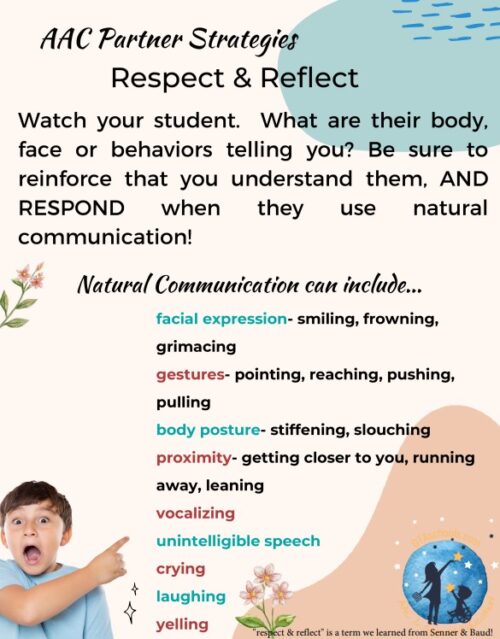

On this website, PrAACtical AAC, you’ll find multiple articles and tools to support you while you support your student! There’s an amazing resource by Tabi Jones-Wohleber called Model as a MASTER PAL. There are 11 modules to help partners hone their skills supporting and encouraging communication in their students. You’ll also find several articles about Prompting AAC, with tips and words of caution. You can search Chain of Cues and Prompting Hierarchies to find even more information.
Working through Step 3: Take In, into Step 4: Try It, can at times occur very quickly, while in other cases, modeling is necessary for an extended period before expecting the student to try themselves. Typically, Step 4 occurs in a therapy or classroom setting during activities planned and directed by a partner, often the speech therapist, teacher, or paraprofessional. Autonomous messages are produced within the activity, meaning that the student is selecting messages they want to say with support as needed. Partners are not directing the topic or telling students what to say; they are watching for the student’s communicative intent, and then supporting them to say what they want to say!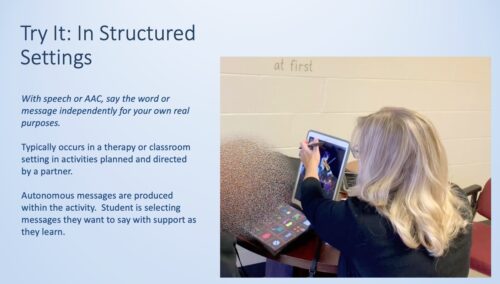
Communication is a dynamic process, and it requires both individuals with communication disabilities and their partners to learn new skills. The need for partners to have knowledge around best practices in encouraging interaction with students who use AAC is well-documented in research. By providing the right support and guidance, individuals with communication disabilities can become more independent and effective communicators, improving their overall quality of life. As you move through our AAC Steps of Learning, you can be assured that your students don’t get “stuck” in a responsive, prompted role of communication.
About the Guest Author
Vicki Clarke is the CEO of Dynamic Therapy Associates, Inc and Director of DTA Schools, a division of DTA Inc, supporting both individual student growth and, system-wide focus on the development of augmentative communication skills, supports, and best practices in special education programs. Additional professional activities include professional consultation and training through publications, workshops, and presentations at local, state, and national conferences in the areas of AAC, speech-language pathology, special education, and Autism.
Filed under: Featured Posts
This post was written by Carole Zangari
